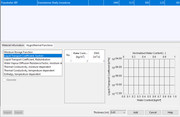
currently there seems to be just one option for Shell Limestone (Muschelkalk) in WUFI.
We often find listed buildings with these claddings (at least here in Germany). The natural stone cladding is often times d = 50 mm thick and sits in a for example d = 20 mm mortar bed.
The component in the WUFI Dataset is "Krensheimer Shelly Limestone"
Unfortunately it shows no data in "Liquid Transport Coefficient, Suction:

How is such a component considered within the calculation? Does it still make sense to use it, or not since a crucial parameter seems to be missing.
It could be one option to unlock it and generate data from approximation parameters but therefore you would need to measure it in advance.
Is there another way?
Thank you all! Greetings

